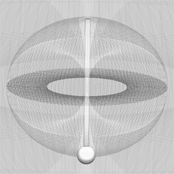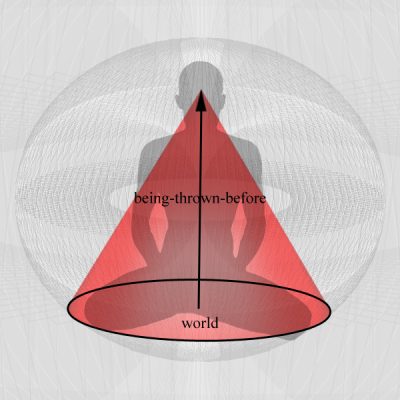




































representational inquiry regarding meaning » reality » world/worldhood
As part of the experiencer-experiencing-experienced axis, the K-node is properly just experienced as such, but as we are already involved in a discursive space of meaning involving particular experiencers experiencing experienced particulars, we paradigmatically understand experienced as such in terms of experienced as world, hence the red color. (The cone pointing up = experienced, and the red color = world.)
As it applies to the K-node, the cone pointing up signifies being-thrown-before. The experienced is being-thrown-before the experiencer just as the experiencer is being-thrown-under the experienced. Speaking in purely formal terms, experienced is paradigmatically a domain of significance—i.e., a world as an holistic object of attention. To ob-ject is to throw in the way of (from [L] ob "in front of, towards, against" + combining form of iacere "to throw"). It's that which shows up as intelligible/meaningful to an experiencer.
The diagrammatic components of the K-node cone include its circular base, its apex, and the line-segments stretching between its base and apex, as centered around its axis. These parts correspond to experienced as world (base), experienced as self (apex), and experienced as dynamic (axis-centered segments). As world, experienced is a (whole) system of significance, or, to quote Richard Polt, "a system of purposes and meanings that organizes our activities and our identity, and within which entities can make sense to us" (from Heidegger, an Introduction [Cornell UP 1999] pg. 54); it's presented as significance. As self, experienced is that which uniquely appears before a particular individual, toward the purely qualitative what-it's-like-ness of particular appearances/presentations. As dynamic, experienced may mean the durational facts, events, and states of affairs presented to anyone of a given world, or it may mean the process whereby one's own qualitative experiences are reconciled with the system of significance. This existential hermeneutical process is most often carried out pre-reflectively, but it can become consciously explicit as the process is presented linguistically, reifying its parts in propositions.

Just as the letter I originally meant hand, the letter K originally meant palm (of the hand). It's an open palm ready to take hold and grasp. It's the potential for grasping. What makes grasping possible is in part that there is something capable of being grasped. And so K may represent that which is capable of being taken hold of, or grasped—viz., some aspect of the world, where world means domain of intelligibility. A world is a region of reality capable of being grasped—an order or orderly arrangement (kosmos). So, just as J represents the potential for selfhood, K represents the potential for worldhood—i.e., that it's possible for reality to present itself as intelligible.
